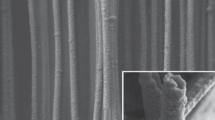Abstract
Nickel nanotubes have been formed in pores of ion-track membranes using electrochemical deposition. Morphologic and structural features of these nanostructures have been comprehensively studied. The evolution of the nanotubes wall thickness and parameters of their crystalline structure by variations of the synthesis voltage and temperature has been determined. On the base of these data the nanotubes growth mechanism has been estimated.
Similar content being viewed by others
References
J. Goldberger, R. He, and Y. Zhang, “Single-crystal gallium nitride nanotubes,” Nature 422, 599–602 (2003).
M. A. Sanchez-Castillo, C. Couto, and W. B. Kim, “gold-nanotube membranes for the oxidation of CO at gas-water interfaces,” Angew. Chem. Int. Ed. 43, 1140–1142 (2004).
A. Kros, R. J. M. Nolte, and N. A. J. M. Sommerdijk, “Conducting polymers with confined dimensions: Track-etch membranes for amperometric biosensor applications,” Adv. Mater. 14, 1779–1782 (2002).
S. Yu, S. B. Lee, and C. R. Martin, “Electrophoretic protein transport in gold nanotube membranes,” Anal. Chem. 75, 1239–1244 (2003).
S. R. Dave and X. W. Gao, “Monodisperse magnetic nanoparticles for biodetection, imaging, and drug delivery: A versatile and evolving technology,” Interdiscip. Rev. Nanomed. Nanobiotechnol. 1, 583–609 (2009).
S. J. Tans, M. H. Devoret, and H. Dai, “Individual single-wall carbon nanotubes as quantum wires,” Nature 386, 474–477 (1997).
H. Dai, J. H. Hafner, and A. G. Rinzler, “Nanotubes as nanoprobes in scanning probe microscopy,” Nature 384, 147–150 (1996).
C. M. Lieber, “One-dimensional nanostructures: Chemistry, physics and applications,” Solid State Commun. 107, 607–616 (1998).
S. E. Demyanov, E. Yu. Kaniukov, A. V. Petrov, and V. Sivakov, “Positive magnetoresistance in Si/SiO2 (Cu/Ni) structures,” Sens. Actuat., A. Phys. 216, 64–68 (2014).
T. Sehayek, M. Lahav, and R. Popovitz-Biro, “Template synthesis of nanotubes by room-temperature coalescence of metal nanoparticles,” Chem. Mater. 17, 3743–3748 (2005).
Y. Li, J. Wang, Z. Deng, Y. Wu, X. Sun, D. Yu, and P. Yang, “Bismuth nanotubes: A rational low-temperature synthetic route,” J. Am. Chem. Soc. 123, 9904–9905 (2001).
V. Haehnel, S. Fähler, and P. Schaaf, “Towards smooth and pure iron nanowires grown by electrodeposition in self-organized alumina membranes,” Acta Mater. 58, 2330–2337 (2010).
E. Kaniukov, A. Kozlovsky, D. Shlimas, D. Yakimchuk, M. Zdorovets, and K. Kadyrzhanov, “Tunable synthesis of copper nanotubes,”IOP Conf. Ser.: Mater. Sci. Eng. 110, 012013, (2016).
A. Kozlovskiy, A. Zhanbotin, M. Zdorovets, I. Manakova, A. Ozernoy, K. Kadyrzhanov, and V. Rusakov, “Study of Ni/Fe Nanotube Properties,” Nucl. Instrum. Meth. Phys. Res. Sec. B: Beam Interactions with Materials and Atoms 365 Part B, 663–667 (2015).
J. R. Morber, Y. Ding, and M. S. J. Haluska, “PLDassisted VLS growth of aligned ferrite nanorods, nanowires, and nanobelts synthesis, and properties,” Phys. Chem. B 110, 21672–21679 (2006).
Z. Liu, Q. Zhang, and G. J. Shi, “Solvothermal synthesis and magneto-optical properties of Zn1–x NixO hierarchical microspheres,” J. Magn. Magn. Mater. 323, 1022–1026 (2011).
C. R. Martin, “Nanomaterials-a membrane-based approach synthetic,” Science 266, 1961–1966 (1994).
C. R. Martin, J. D. Klein, and R. D. Herric, “Electrochemical fabrication of cadmium chalcogenide microdiode arrays,” Chem. Mater. 5, 902–904 (1993).
Z. Hua, S. Yang, and H. Huang, “Metal nanotubes prepared by a sol–gel method followed by a hydrogen reduction procedure,” Nanotecnology 17, 5106–5110 (2006).
M. Zdorovets, I. Ivanov, and V. Alexandrenko, “Accelerator complex based on DC-60 cyclotron, in Proc. RuPAC, pp. 287–289 (2014).
S. E. Demyanov, E. Yu. Kaniukov, and A. V. Petrov, “On the morphology of Si/SiO2/Ni nanostructures with swift heavy ion tracks in silicon oxide,” J. Surf. Inv. X-ray, Synchr. Neutron Tech. 8, 805–813 (2014).
S. Barth, S. Estrade, and F. Hernandez-Ramirez, “Morphological evolution and chemical composition of vapor grown one-dimensional magnetite nanostructures,” Cryst. Growth Des. 9, 1077–1081 (2009).
M. G. Faraj and K. Ibrahim, “Optical and structural properties of thermally evaporated zinc oxide thin films on polyethylene terephthalate substrates,” Int. J. Polym. Sci. 2011, 302843 (2011).
R. Jenkins and R. L. Snyder, Introduction to X-ray Powder Diffractometry (Wiley, 1996), pp. 89–91.
B. Yoo, F. Xiao, and K. N. Bozhilov, “Electrodeposition of thermoelectric superlattice nanowires,” Adv. Mater. 19, 296–299 (2007).
M. Motoyama, Y. Fukunaka, and T. Sakka, “Initial stages of electrodeposition of metal nanowires in nanoporous templates,” Electrochim. Acta 53, 205–212 (2007).
B. Bercu, I. Enculescu, and R. Spohr, “Copper tubes prepared by electroless deposition in ion track templates,” Nucl. Instrum. Meth. Phys. Res. Sec. B: Beam Interactions with Materials and Atoms 225, 497–502 (2004).
H. Cao, L. Wang, Y. Qiu, Q. Wu, G. Wang, L. Zhang, and X. Liu, “Generation and growth mechanism of metal (Fe, Co, Ni) nanotube arrays,” Chem. Phys. Chem. 7, 1500–1504 (2006).
L. M. Graham, S. Cho, S. K. Kim, M. Noked, and S. B. Lee, “Role of boric acid in nickel nanotube electrodeposition: A surface-directed growth mechanism,” Chem. Commun. 50, 527–529 (2014).
T. Chowdhury, D. P. Casey, and J. F. Rohan, “Additive influence on Cu nanotube electrodeposition in anodized aluminum oxide templates,” Electrochem. Commun. 11, 1203–1206 (2009).
T. A. Tochitskii and V. M. Fedosyuk, Electrolytic Deposition of Films and Nanostructures (Izd. tsentr BGU, Minsk, 2011) [in Russian].
M. Ya. Popeka, Internal Stresses of Electrolytically Deposited Metals (Zap.-Sib. knizhnoe Izd-vo, Novosibirsk, 1966) [in Russian].
Author information
Authors and Affiliations
Corresponding author
Additional information
Original Russian Text © A.L. Kozlovskiy, D.I. Shlimas, A.E. Shumskaya, E.Yu. Kaniukov, M.V. Zdorovets, K.K. Kadyrzhanov, 2017, published in Fizika Metallov i Metallovedenie, 2017, Vol. 118, No. 2, pp. 174–179.
Rights and permissions
About this article
Cite this article
Kozlovskiy, A.L., Shlimas, D.I., Shumskaya, A.E. et al. Influence of electrodeposition parameters on structural and morphological features of Ni nanotubes. Phys. Metals Metallogr. 118, 164–169 (2017). https://doi.org/10.1134/S0031918X17020065
Received:
Accepted:
Published:
Issue Date:
DOI: https://doi.org/10.1134/S0031918X17020065



